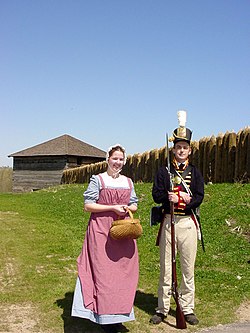Fort Meigs
|
Fort Meigs
|
|

Dressed in clothing of the period, these guides at Fort Meigs Historic Site prepare to give a tour of the facility on a clear day in the summer
|
|
| Location | Perrysburg, Ohio |
|---|---|
| Coordinates | 41°33′10″N 83°39′6″W / 41.55278°N 83.65167°WCoordinates: 41°33′10″N 83°39′6″W / 41.55278°N 83.65167°W |
| Built | 1813 |
| NRHP Reference # | 69000151 |
| Added to NRHP | August 4, 1969 |
Fort Meigs was a United States fortification along the Maumee River in Ohio during the War of 1812. The British army, supported by Tecumseh's Confederacy, failed to capture the fort during the Siege of Fort Meigs. It is named in honor of Ohio governor Return J. Meigs, Jr., for his support in providing General William Henry Harrison with militia and supplies for the line of forts along the Old Northwest frontier.
Construction of the fort started in February 1813 by soldiers under the command of General William Henry Harrison (future president) at a site where present-day Perrysburg, Ohio developed. It was to provide a supply depot and staging point for US military operations in Canada that would also command the rapids of the Maumee River. The remnants of the British Fort Miami were across the river downstream, to the northeast. The winter climate was harsh, and the landscape unforgiving. A U.S. sentry froze to death during his two hours of guard duty. The walls were constructed using logs cut to a 15-foot length, partially buried in the ground, then protected by a steep earthen slope thrown against the logs to strengthen them against bombardment. An embankment against the interior side provided a parapet. When completed, the fort was the largest wooden walled fortification in North America.
The First Siege: On May 1, 1813, British allied forces, under General Henry Proctor and Chief Tecumseh, opened a bombardment of the fort, which had mustered 1,200 regulars and militia, and laid siege. Reinforcements reached the fort on May 4, increasing its garrison to 2,800. Early on the morning of May 5, a detachment from Clay's brigade under Colonel William Dudley landed from boats on the north bank of the river, stormed the British batteries on the north bank and spiked the guns. Coming under fire from Indians in the woods, part of the Kentuckian force pursued Tecumseh's men, who led them deeper into the forest. In the woods, the disorganized Kentuckians suffered heavy casualties in confused fighting. Nearly 550 were captured, and of Dudley's 866 officers and men, only 150 returned to the fort. This became known as "Dudley's Massacre" or "Dudley's Defeat".
...
Wikipedia


